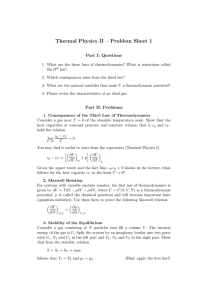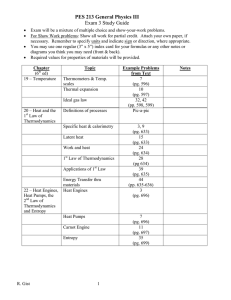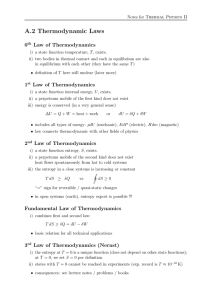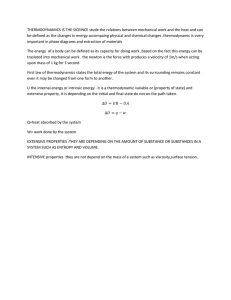ESCI 341 – Atmospheric Thermodynamics Lesson 3 – The First Law
advertisement
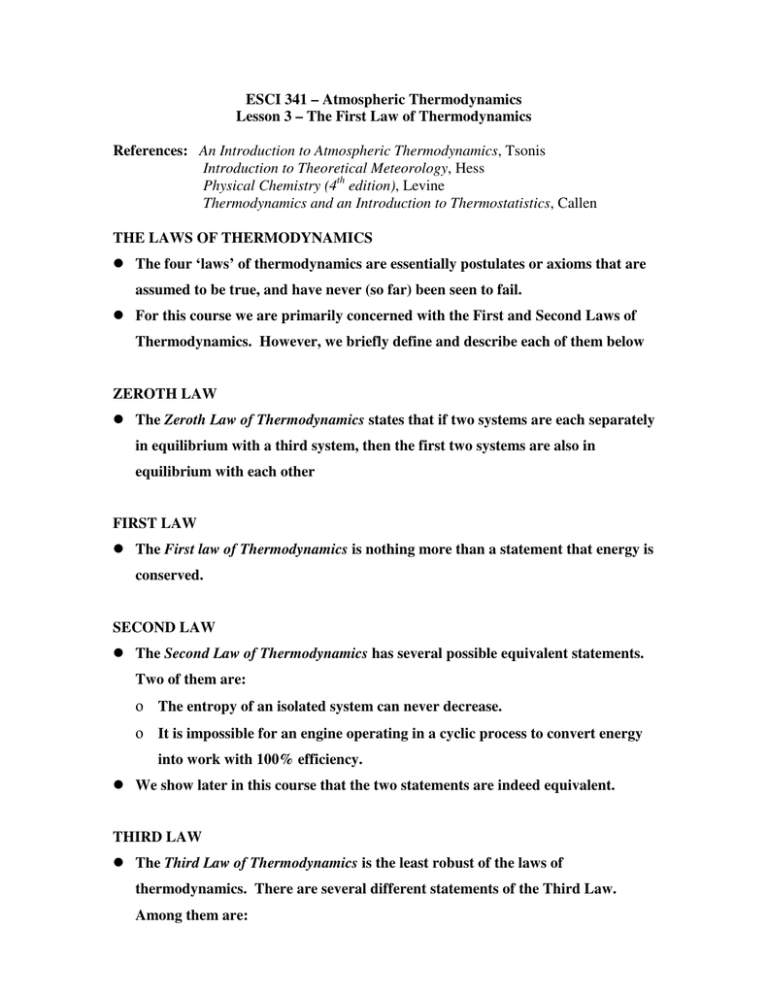
ESCI 341 – Atmospheric Thermodynamics Lesson 3 – The First Law of Thermodynamics References: An Introduction to Atmospheric Thermodynamics, Tsonis Introduction to Theoretical Meteorology, Hess Physical Chemistry (4th edition), Levine Thermodynamics and an Introduction to Thermostatistics, Callen THE LAWS OF THERMODYNAMICS The four ‘laws’ of thermodynamics are essentially postulates or axioms that are assumed to be true, and have never (so far) been seen to fail. For this course we are primarily concerned with the First and Second Laws of Thermodynamics. However, we briefly define and describe each of them below ZEROTH LAW The Zeroth Law of Thermodynamics states that if two systems are each separately in equilibrium with a third system, then the first two systems are also in equilibrium with each other FIRST LAW The First law of Thermodynamics is nothing more than a statement that energy is conserved. SECOND LAW The Second Law of Thermodynamics has several possible equivalent statements. Two of them are: ο The entropy of an isolated system can never decrease. ο It is impossible for an engine operating in a cyclic process to convert energy into work with 100% efficiency. We show later in this course that the two statements are indeed equivalent. THIRD LAW The Third Law of Thermodynamics is the least robust of the laws of thermodynamics. There are several different statements of the Third Law. Among them are: ο The entropy change of a substance goes to zero as temperature approaches absolute zero. ο The entropy of a pure substance is zero at absolute zero. A consequence or result of the First, Second, and Third Laws is that it is impossible to reduce the temperature of a substance to absolute zero (0 K) in a finite number of steps. ο In other words, it would take an infinite number of steps to reach absolute zero, so therefore, it is unattainable. The unattainability of absolute zero is sometimes regarded as being another alternate statement of the Third Law of Thermodynamics, however, it is actually a consequence of the First, Second, and Third Laws (see Levine, pp. 159 for details if interested). As of 2009 the coldest temperature achieved is 3×10−9 K. THE FIRST LAW OF THERMODYNAMICS IN DETAIL The first law of thermodynamics expresses the conservation of energy. It is given as dU = dQ + dW . The first law states that the internal energy of a system can be changed either through heating or through work. Using intensive properties, the first law becomes du = dq + dw . Our convention will be that heat added to the system and work done on the system will be positive. ο Thus, work done by the system on its surroundings will be negative. P-V WORK Work is defined as force acting over a distance, dW = F • dx . If a gas expands quasi-statically against a pressure, p, the work done by the gas is given by the pressure multiplied by the change in volume, V, or dW = − pdV . 2 ο This definition of work is only valid if the process is quasi-static, so that the system remains in equilibrium throughout the process. ο The negative sign is included because work is being done by the system. The first law is then written dU = dQ − pdV , (1) ο In terms of specific quantities, the first law is du = dq − pdα , where α is the specific volume (V/m, or ρ −1). NOTE: In the “old days” it was common to define positive work as work done “by” the system, so that the first law would be dU = dQ − dW, and the work term would be defined as dW = pdV. Modern convention is to define positive work as work done “on” the system, so that dU = dQ + dW and dW = −pdV. Either convention leads to the correct form of expression (1), so it really doesn’t matter, as long as you are consistent. The first law in this form tells us that if a gas expands then its internal energy must either decrease, or heat must be added to it in order to keep the internal energy from decreasing. ο In an adiabatic process, no heat is added or subtracted. Therefore dq = 0. This means that if a gas expands adiabatically its internal energy (and hence, its temperature) will decrease. 3 EXERCISES 1. Prove that for a volume of arbitrary shape that the work done in expanding the volume by a differential volume, dV, is pdV. Hint: Imagine every where on the surface of the volume that the surface is pushed out an amount dn , where n is a vector whose direction is everywhere normal to the surface. 2. a. What is the minimum amount of work done by you in blowing up a spherical party balloon to a diameter of 8 inches? Assume standard sea-level pressure. b. Why is this the minimum amount of work? 4
